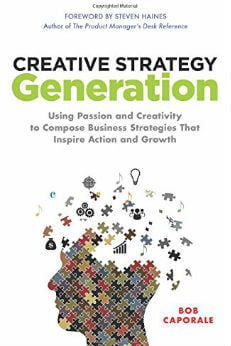Content
Freshness
Summary
If you KNOW that you need to take a new fresh new look at your strategic planning and what you’ve seen out there so far has left you uninspired, then “Creative Strategy Generation” will give you a fresh new look at creating a business strategy that not only inspires you, but engages your team and disrupts your competition.

Did you ever wonder how some of the companies or leaders that you admire came up with the strategies that have made their businesses so successful? You’re not alone.
Author Bob Caporale (@bobcaporale) wondered the same thing. As he looked around the business strategy landscape, he noticed that there are three primary ways to approach corporate strategy; there is the academic, case study approach, the consultative approach and the personal experience approach.
In “Creative Strategy Generation: Using Passion and Creativity to Compose Business Strategies That Inspire Action and Growth” Caporale explores a fourth way of looking at strategy — applying your own creative process to the art of strategic planning.
An Interesting New Way to Think About Strategic Planning
“Creative Strategy Generation” explores the connections between theoretical and functional techniques and demystifies the complexities of developing a strategic plan. The book will show you how to:
- Clear your mind for new ideas by condensing and organizing your existing business knowledge, data and beliefs;
- Find your strategic inspiration and turn it into the vision, goals and objectives that will drive your plan;
- Deeply understand your target customers and formulate strategies that address their needs and wants;
- Use storytelling to create messages and generate interest and engagement by establishing an emotional connection.
The author leans heavily on his experience as both a composer and a business strategist to draw parallels between inspired music and business strategy.
About the Author
Caporale describes himself as an “Author, Composer, Speaker.” He isn’t just a business strategist. He’s a music composer as well. In fact, his musical expertise and experience heavily influenced this book. Caporale’s compositions can be heard on the Web and in a variety of corporate and video soundtracks.
He is also the president of Sequent Learning Networks, a New York City-based training and advisory firm specializing in product management, product marketing and strategic planning.
Caporale has held leadership and executive roles in engineering, marketing, product management and general management for multi-billion dollar companies. It’s this broad base of experience that lends such practicality and depth to “Creative Strategy Generation.”
What Happens When You Use Left and Right Brain Thinking?
The best thing about this book has to be the unusual comparison between composing a musical piece and creating a business strategy. This is something that only someone with enough experience in both can do, but that all of us can appreciate.
Another element I really liked was the appendix in the back of the book. “Creative Strategy Generation” has many processes that are hard to keep track of, so the appendix in the back is a really useful add-on and will help you and your team work through each of the elements of Caporale’s planning process.
Written for Experienced Planners
“Creative Strategy Generation” is primarily written for medium sized businesses with employees and infrastructure. The tone and style of the book is directed at business owners, product managers and professional marketers who have some experience in strategic planning.
If you are a newbie or a startup with limited experience, you’ll enjoy this book for the context and general information, but you might find some elements of it to feel overwhelming.
Reimagining Stale Planning Elements Opens Up New Opportunities
You’ll want to read “Creative Strategy Generation” for the sheer curiosity of seeing how Caporale intertwines foundational principles of music composition with strategic planning. I was blown away by how my brain immediately went to new ideas and new possibilities for differentiation from competitors.
For example, in the section on the typical “SWOT” analysis in Chapter 3, Caporale re-frames this tired process by simply adding elements of time (present and future) and the structure of internal and external. These simple additions instantly elevate this tired exercise and lead you to a more constructive and useful outcome.
Experienced strategic planners will LOVE “Creative Strategy Generation” because it takes a familiar topic and puts it in a context that you’ve never really thought of before.
[“source-smallbiztrends”]




